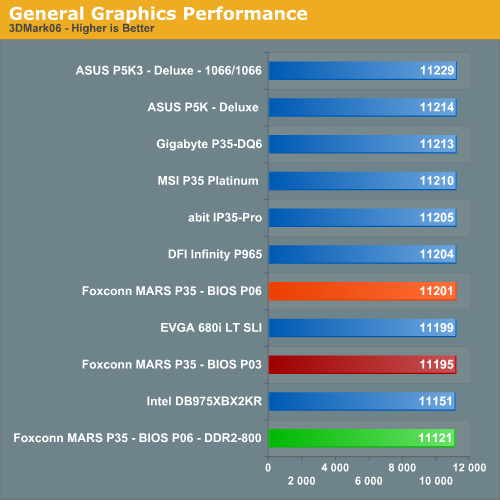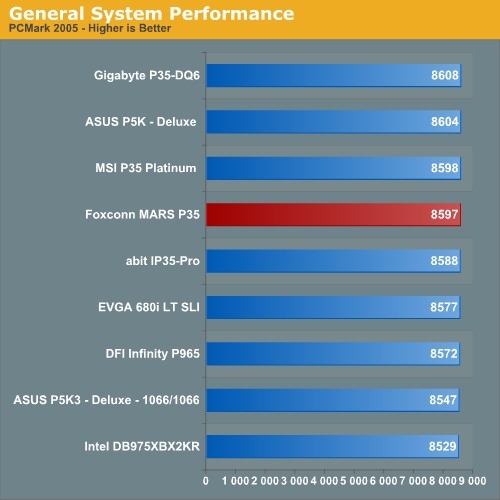Foxconn MARS: God of War Performance?
by Gary Key on September 21, 2007 12:00 PM EST- Posted in
- Motherboards
Synthetic Graphics Performance
The 3DMark series of benchmarks developed and provided by Futuremark are among the most widely used tools for benchmark reporting and comparisons. Although the benchmarks are very useful for providing apple to apple comparisons across a broad array of GPU and CPU configurations they are not a substitute for actual application and gaming benchmarks. In this sense we consider the 3DMark benchmarks to be purely synthetic in nature but still valuable for providing consistent measurements of performance.


In our 3DMark06 test, all of the boards are within 1% of each other. When looking at the individual tests, the Foxconn board scores slightly better in the CPU tests but is second to last in the the SM2.0 and SM3.0 tests.
In the more memory and CPU throughput sensitive 3DMark01 benchmark we see the spread between boards is way under 1%. The Foxconn board scores near the top in each category except the Nature Test where it's just barely ahead of the 975X board.
General System Performance
The PCMark05 benchmark developed and provided by Futuremark is designed to measure overall system performance for the typical home computing user. This tool provides both system and component level benchmarking results utilizing subsets of real world applications or programs. This benchmark is useful for providing comparative results across a broad array of Graphics, CPU, Hard Disk, and Memory configurations along with multithreading results. In this sense we consider the PCMark benchmark to be both synthetic and real world in nature and it again provides consistency in our benchmark results.

Once again, all of the boards are basically within shouting range of each other with the Foxconn board finishing near the top of the pack. The MARS board does very well in the Hard Disk and CPU sections while falling towards the rear of the pack in the graphics test.
The 3DMark series of benchmarks developed and provided by Futuremark are among the most widely used tools for benchmark reporting and comparisons. Although the benchmarks are very useful for providing apple to apple comparisons across a broad array of GPU and CPU configurations they are not a substitute for actual application and gaming benchmarks. In this sense we consider the 3DMark benchmarks to be purely synthetic in nature but still valuable for providing consistent measurements of performance.


In our 3DMark06 test, all of the boards are within 1% of each other. When looking at the individual tests, the Foxconn board scores slightly better in the CPU tests but is second to last in the the SM2.0 and SM3.0 tests.
In the more memory and CPU throughput sensitive 3DMark01 benchmark we see the spread between boards is way under 1%. The Foxconn board scores near the top in each category except the Nature Test where it's just barely ahead of the 975X board.
General System Performance
The PCMark05 benchmark developed and provided by Futuremark is designed to measure overall system performance for the typical home computing user. This tool provides both system and component level benchmarking results utilizing subsets of real world applications or programs. This benchmark is useful for providing comparative results across a broad array of Graphics, CPU, Hard Disk, and Memory configurations along with multithreading results. In this sense we consider the PCMark benchmark to be both synthetic and real world in nature and it again provides consistency in our benchmark results.

Once again, all of the boards are basically within shouting range of each other with the Foxconn board finishing near the top of the pack. The MARS board does very well in the Hard Disk and CPU sections while falling towards the rear of the pack in the graphics test.










17 Comments
View All Comments
Griswold - Sunday, September 23, 2007 - link
I see they also implemented the Northbridge<->PWM section cooling with heatpipes. Recipe for hot PWM with an Overclocked 4 core CPUHumbug. The PWMs with an overclocked quad will be hotter than a P35 NB - and they also can take alot more heat than a NB. Dont make issues up where there are none.
kmmatney - Saturday, September 22, 2007 - link
it seems like it would be better just to remove the covers over chipset heatsinks - don't they just reduce airflow? The coolpipe logo piece should just be taken off altogether.wolfman3k5 - Saturday, September 22, 2007 - link
Nice review, thanks allot! I want to buy one of these, where can I find this board?JarredWalton - Saturday, September 22, 2007 - link
Not out at retail quite yet - early next month I believe.cmdrdredd - Saturday, September 22, 2007 - link
Good board from the review, but it's a little late. Those who were looking to adopt P35 already have one of the other boards, everyone else wants to see X38. I suppose it would depend on the price of this board vs others once it hits actual retail channels.Griswold - Sunday, September 23, 2007 - link
Your world must be really small.strikeback03 - Monday, September 24, 2007 - link
Then again, didn't Gary Key say in the comments on the ASUS X38 board that he expects X38 to take over this market segment once initial hysteria wears off; as performance should be better than P35 for the same money. Then P35 would primarily work in the midrange.